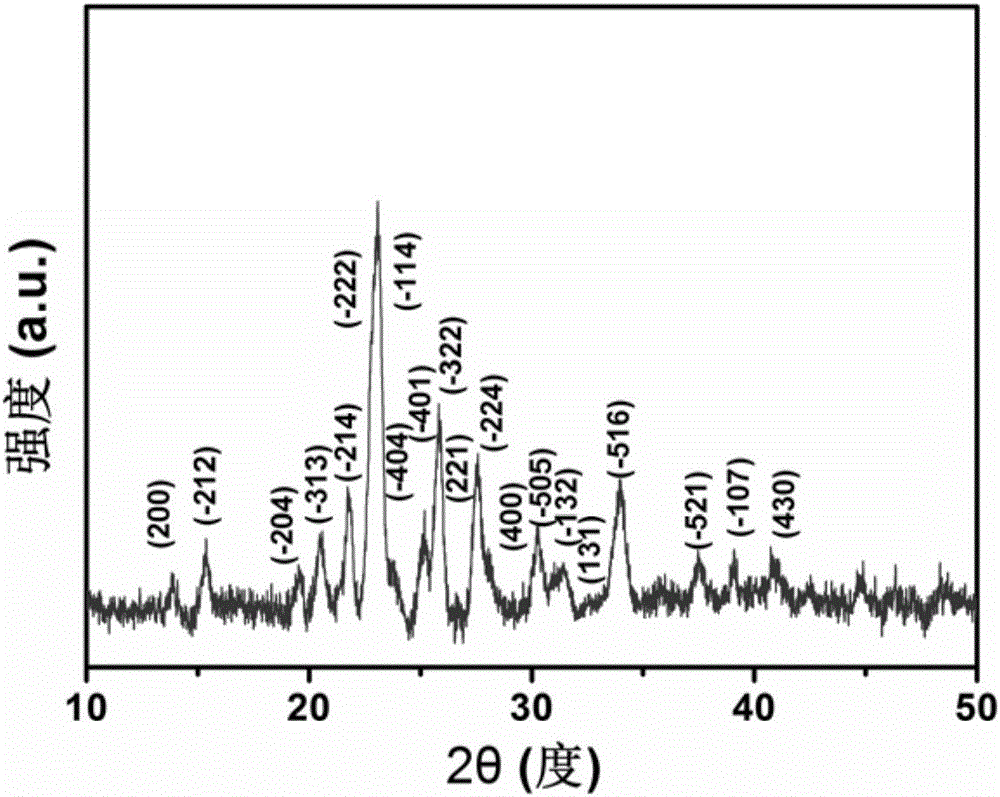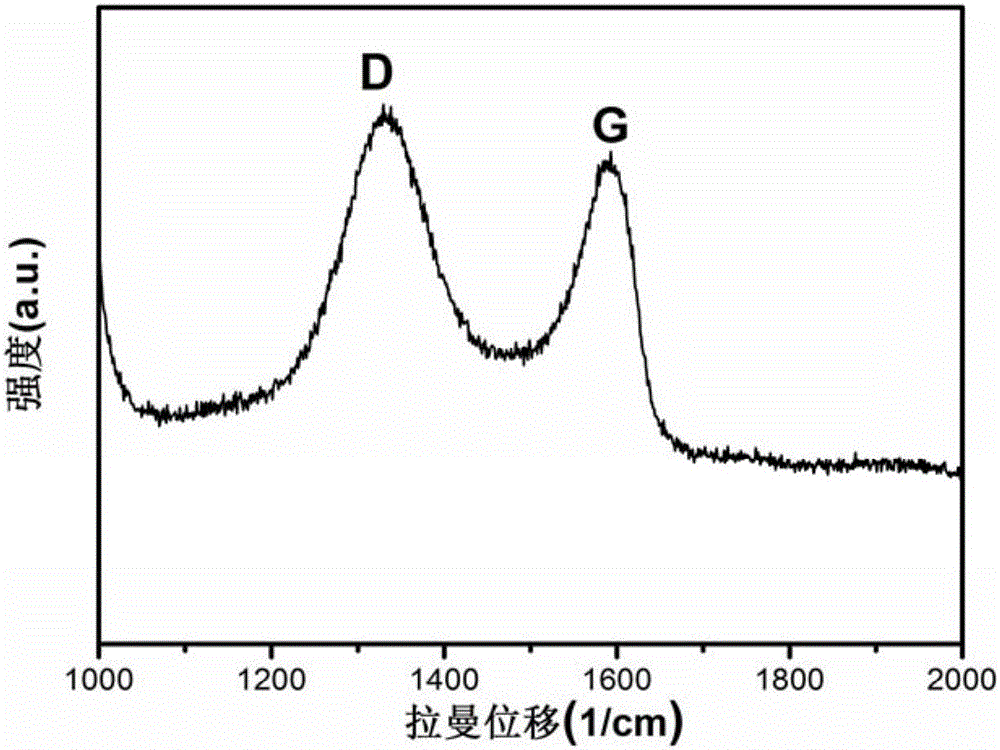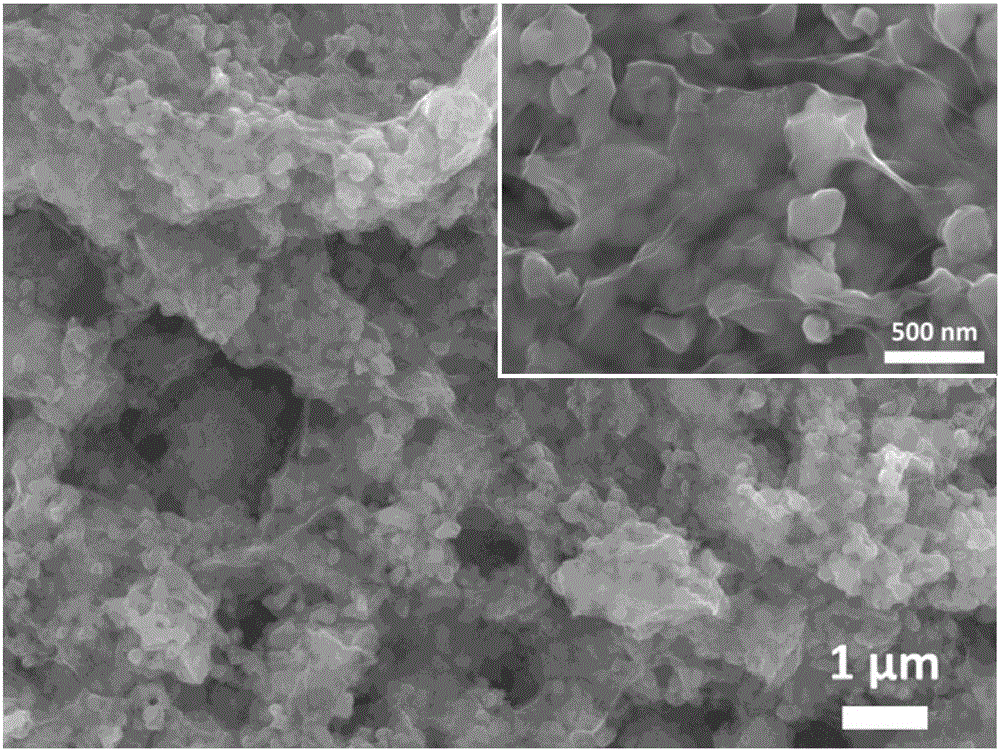Graphene clad Fe2(MoO4)3 nanoparticle and preparation method and application thereof
A graphene-coated, nano-particle technology, applied in the field of Fe23 nano-particle preparation, achieves high specific capacity, high electronic conductivity, and is conducive to market promotion.
- Summary
- Abstract
- Description
- Claims
- Application Information
AI Technical Summary
Problems solved by technology
Method used
Image
Examples
Embodiment 1
[0029] Graphene-coated Fe 2 (MoO 4 ) 3 A method for preparing nanoparticles, comprising the steps of:
[0030] 1) Mix 20 mL of cyclohexanol and 20 mL of cyclohexane, and add 0.4 g of sodium lauryl sulfate to obtain a mixed solution.
[0031] 2) Dissolve 0.56g of ferric nitrate in 15mL of deionized water to obtain solution A, dissolve 0.37g of ammonium heptamolybdate in 15mL of deionized water to obtain solution B, and add A and B solutions to the mixed solution obtained in step 1) in turn Stir in.
[0032] 3) The product obtained in step 2) is centrifugally filtered, the obtained precipitate is repeatedly washed with deionized water and alcohol, and dried at 70° C. to obtain the nanowire precursor.
[0033] 4) Put the precursor obtained in step 3) into a muffle furnace, heat it up to 500°C in the air and keep it warm for 2 hours, then cool naturally to room temperature to obtain Fe 2 (MoO 4 ) 3 nanoparticles;
[0034] 5) Take 0.15 g of the ferric molybdate particles pr...
Embodiment 2
[0040] Graphene-coated Fe 2 (MoO 4 ) 3 A method for preparing nanoparticles, comprising the steps of:
[0041] 1) Mix 25 mL of cyclohexanol and 25 mL of n-pentanol, and add 0.3 g of cetyltrimethylammonium bromide to obtain a mixed solution.
[0042] 2) Dissolve 0.56g ferric nitrate in 15mL deionized water to obtain solution A, dissolve 0.37g ferric molybdate in 15mL deionized water to obtain solution B, and add A and B solutions to the mixed solution obtained in step 1) in sequence Stir.
[0043] 3) The product obtained in step 2) is centrifugally filtered, the obtained precipitate is repeatedly washed with deionized water and alcohol, and dried at 70° C. to obtain the nanowire precursor.
[0044] 4) Put the precursor obtained in step 3) into a muffle furnace, raise the temperature to 500°C in the air and keep it warm for 2 hours, then cool naturally to room temperature to obtain Fe 2 (MoO 4 ) 3 nanoparticles.
[0045] 5) Take 0.15 g of the ferric molybdate particles p...
Embodiment 3
[0050] Graphene-coated Fe 2 (MoO 4 ) 3 A method for preparing nanoparticles, comprising the steps of:
[0051] 1) Mix 15 mL of cyclohexanol and 15 mL of cyclohexane, add 0.3 g of sodium lauryl sulfate to obtain a mixed solution;
[0052] 2) Dissolve 0.56g of ferric nitrate in 15mL of deionized water to obtain solution A, dissolve 0.37g of ammonium heptamolybdate in 15mL of deionized water to obtain solution B, and add A and B solutions to the mixed solution obtained in step 1) in turn Stir in.
[0053] 3) The product obtained in step 2) is centrifugally filtered, the obtained precipitate is repeatedly washed with deionized water and alcohol, and dried at 70° C. to obtain the nanowire precursor.
[0054] 4) Put the precursor obtained in step 3) into a muffle furnace, heat it up to 500°C in the air and keep it warm for 2 hours, then cool naturally to room temperature to obtain Fe 2 (MoO 4 ) 3 nanoparticles.
[0055] 5) Take 0.15 g of the ferric molybdate particles prepar...
PUM
| Property | Measurement | Unit |
|---|---|---|
| volume | aaaaa | aaaaa |
| volume | aaaaa | aaaaa |
| diameter | aaaaa | aaaaa |
Abstract
Description
Claims
Application Information
 Login to View More
Login to View More - R&D
- Intellectual Property
- Life Sciences
- Materials
- Tech Scout
- Unparalleled Data Quality
- Higher Quality Content
- 60% Fewer Hallucinations
Browse by: Latest US Patents, China's latest patents, Technical Efficacy Thesaurus, Application Domain, Technology Topic, Popular Technical Reports.
© 2025 PatSnap. All rights reserved.Legal|Privacy policy|Modern Slavery Act Transparency Statement|Sitemap|About US| Contact US: help@patsnap.com



